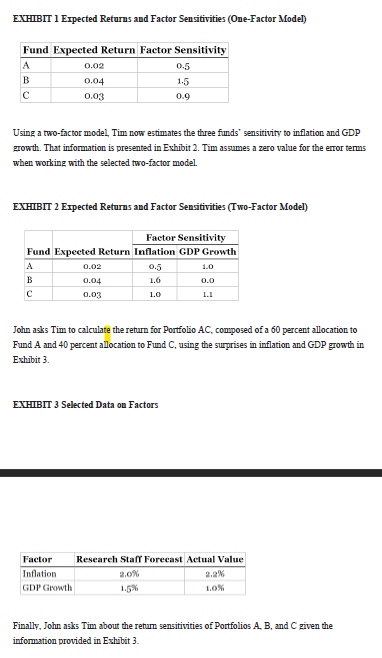Question
John is a manager-of-managers at an investment company that uses quantitative models extensively. John seeks to construct a multi-manager portfolio using some of the funds
John is a manager-of-managers at an investment company that uses quantitative models extensively. John seeks to construct a multi-manager portfolio using some of the funds managed by portfolio managers within the firm. Tim is assisting him. John uses arbitrage pricing theory (APT) as a basis for evaluating strategies and managing risks. From his earlier analysis, Tim knows that Funds A and B in Exhibit 1 are well diversified. He has not previously worked with Fund C and is puzzled by the data because it is inconsistent with APT. He asks Tim gather additional information on Fund C's holdings and to determine if an arbitrage opportunity exists among these three investment alternatives. His analysis, using the data in Exhibit 1, confirms that an arbitrage opportunity does exist.

EXHIBIT 1 Expected Returns and Factor Sensitivities (One-Factor Model) Fund Expected Return Factor Sensitivity A 0.02 B 0.04 C 0.03 0.5 1.5 0.9 Using a two-factor model, Tim now estimates the three funds' sensitivity to inflation and GDP growth. That information is presented in Exhibit 2. Tim assumes a zero value for the error terms when working with the selected two-factor model. EXHIBIT 2 Expected Returns and Factor Sensitivities (Two-Factor Model) Factor Sensitivity Fund Expected Return Inflation GDP Growth A 0.02 0.5 1.0 B 0.04 1.6 0.0 C 0.03 1.0 1.1 John asks Tim to calculate the return for Portfolio AC, composed of a 60 percent allocation to Fund A and 40 percent allocation to Fund C, using the surprises in inflation and GDP growth in Exhibit 3. EXHIBIT 3 Selected Data on Factors Factor Inflation GDP Growth Research Staff Forecast Actual Value 2.0% 1.5% 2.2% 1.0% Finally, John asks Tim about the return sensitivities of Portfolios A, B, and C given the information provided in Exhibit 3.
Step by Step Solution
There are 3 Steps involved in it
Step: 1
To calculate the return for Portfolio AC composed of a 60 allocation to Fund A and a 40 allocation to Fund C using the surprises in inflation and GDP growth provided in Exhibit 3 we first need to calc...
Get Instant Access to Expert-Tailored Solutions
See step-by-step solutions with expert insights and AI powered tools for academic success
Step: 2

Step: 3

Ace Your Homework with AI
Get the answers you need in no time with our AI-driven, step-by-step assistance
Get Started


